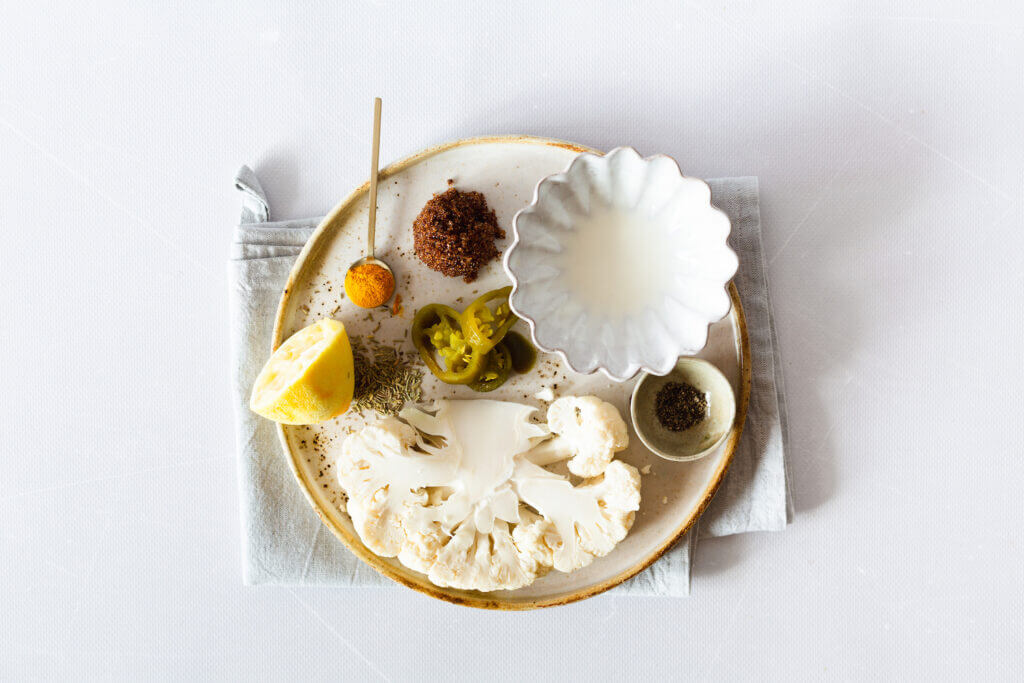Cauliflower dip recipe with glazed carrots
- 3

undefined 10'

undefined 15'

undefined

undefined
- 3

undefined 10'

undefined 15'

undefined

undefined
The humble cauliflower
Cauliflower suffers from a bit of a reputation problem. It doesn’t have the hipster-level cool of the avocado, or the child-pleasing sweetness of peas and carrots. It lacks the vibrant colours of stripy purple aubergines or cheerful squash.
In fact, most of the time cauliflower resides in the category of vegetables we remember being made to eat as children, ‘because it’s good for us’.
Fortunately, cauliflower is having a bit of a renaissance. We couldn’t be happier. After all, cauliflower’s weaknesses are also its strengths: it has a gentle natural flavour, which greedily soaks up spices and sauces. It has an inoffensive texture which goes with just about everything.
And we’ve suddenly discovered innumerable ways of cooking and eating cauliflower which really makes the best of this super vegetable. (Spoiler: boiling it to death in a pan of water is not one of them.)
So, from whole roasted cauliflower laden with heady spices, to cosy, golden-topped creamed cauliflower, it’s about time this underrated vegetable got its time in the spotlight.

The benefits of cauliflower
Like many other vegetables, cauliflower is low in calories while punching seriously above its weight in terms of nutrition.
For example, a cup of cooked cauliflower provides a mere 29 calories, but an impressive 10% of your daily fibre intake and 61% of the vitamin C you need for the day.
It also contains only 0.6g fat and is a decent source of vitamin K.
That said, the way you cook your cauliflower makes a big difference. The way we used to eat it as kids - boiled in salty water until floppy and sad - is now out of vogue.
As it turns out, studies have shown that this is the worst way to cook cauliflower as it results in the highest amount of antioxidants, protein and minerals being lost during cooking.(1)
So, not only does it produce a rather watery, tasteless accompaniment to your meal, you’re also losing a lot of the good stuff in your cooking water.
Instead, try roasting or stir-frying. Or, if you’d prefer to avoid using oil, steaming your cauliflower is the best way to go. You’ll get a better texture as well as more nutritious veg.
If you’re able to, we recommend steaming the cauliflower florets for your dip as you want to avoid the crisp coating created when they are fried. Aim instead for a firm but tender texture, which you should achieve after 4-8 minutes of steaming (depending on the size of your florets).
A rainbow of punchy flavours
For the dressing of our dip, we first needed a base for the sauce. Here, we’ve chosen soy yoghurt; coconut or almond yoghurt would be too overpowering an addition. However, once the base is out of the way, we can get onto the flavoursome ingredients which make this dish so delicious.
Firstly: jalapeño pepper. You can get jalapeños fresh from specialist grocers, but it’s easier to get hold of the jarred variety. Plus, they bring a lovely sharp flavour from the pickling vinegar.
(NB: most jalapeño brands on the market are indeed pickled in vinegar, so unfortunately don’t have the gut-friendly goodness of naturally fermented pickles. However, a few organic stores do sell fermented jalapeños, so shop around).
Next up, naturally anti-inflammatory turmeric, which brings spice and riotous colour. A squeeze of lemon ups the acidity factor, which calls for a hint of sweetness…
Making our glazed carrots
Carrots are naturally quite sweet anyway, thanks to their natural sugars, but they really come alive when glazed.
Here, we chose soft, dark brown sugar for a treacly depth of flavour. However, you could easily substitute maple syrup, or even honey, if you’re avoiding refined sugar.
Carrot and rosemary have always been a match made in heaven, but it’s a less appreciated fact that rosemary goes nicely with lots of sweet flavours. It makes an appearance in lots of grown up desserts - from ice cream to pound cake - and is equally at home lending its earthy flavours to our carrot glaze.
Dried or fresh rosemary works fine; if you go with fresh, remember to remove and discard the twiggy stems and finely chop the leaves. You may need to add a little more to get the right balance of flavours, as dried herbs usually have a stronger taste and fragrance.
How to serve
This is the sort of lunch we crave after a morning’s work tapping away at our laptops. It’s sharp and energising, provides two of your five a day, and is light yet filling. In other words, it’ll set you up for a good afternoon.
Scoop it up with our seed-packed crackers. Flavour-wise, we like the savoury heft of our Greek Olive Crackers here, as a counterbalance to the light acidic notes of the dip. Alternatively, double down on sharp and spritely flavours with our Kimchi Crackers.
You could also serve this dip as part of a spread for several people (and we have lots of other recipes for dips and nibbles should you be short of ideas). Simply scale up the recipe as desired and serve on a large platter, scattered with the glazed carrots and resting alongside a tower of crackers.
Cauliflower dip:
- 200g cooked cauliflower florets, chopped
- 150g plain soy yogurt
- 1 tbsp finely chopped jalapeño pepper
- 1 tsp ground black pepper
- Pinch of sea salt
- ⅓ tsp turmeric powder
- 1 tsp lemon juice
Glazed carrots:
- 20g vegan butter
- 60g sliced carrot
- 1 tbsp soft dark brown sugar
- Pinch of sea salt
- ½ tsp dried rosemary
- Size: 120 g
- Serv. size: 5.9 g
- Add the cooked cauliflower florets to a bowl and mix together with soy yogurt and lemon juice. Add salt, turmeric, chopped jalapeño and black pepper. Mix well and set aside.
- Heat the butter in a frying pan and add the sliced carrots. Sauté on medium heat for 5 minutes until softened.
- Add the soft dark brown sugar and mix. Cook for 2 more minutes on low heat until the sugar is dissolved. Add salt and rosemary.
- Spread the cauliflower mixture on a serving plate and top with the sweet glazed carrots. Enjoy with crackers!
